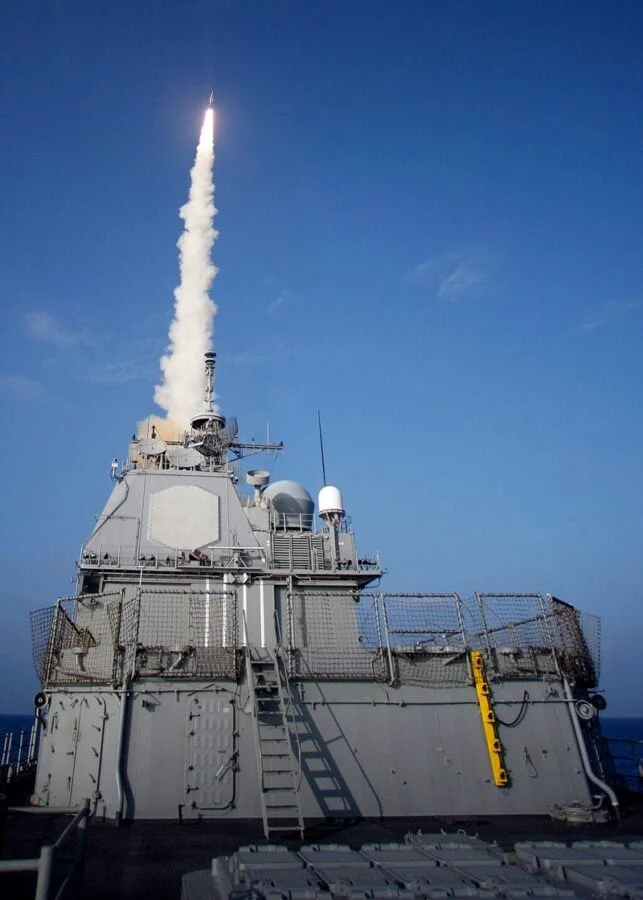For the first time in history, the United States used SM-3 missiles from a missile defense shield in a combat situation (video)
During the joint defense of Israel against Iran’s combined massive attack on April 13, 2024. For the first time in history, the U.S. Armed Forces used RIM-161 Standard Missile 3 (SM-3) missiles of the Aegis missile defense system to intercept real targets.
According to Business Insider, citing U.S. Secretary of the Navy Carlos Del Toro, the U.S. Navy used several RIM-161 Standard Missile 3 (SM-3) missiles to intercept Iranian ballistic missiles aimed at Israel.
“We’ve used SM-2s, we’ve used SM-6s, and this weekend some SM-3s to counter the ballistic missile threat coming from Iran,” Del Toro said during a hearing at the US Senate Appropriations Subcommittee.
USNI News, citing unnamed representatives of the US Defense Department, reported earlier that two US Navy ships had fired four to seven SM-3 anti-missiles to intercept Iranian ballistic missiles. Del Toro’s comments to lawmakers are the first public acknowledgment of the use of SM-3.

The RIM-161 Standard Missile 3, better known as the SM-3, is the most powerful and advanced part of the Aegis missile defense system, the US anti-nuclear umbrella. SM-3 missiles are capable of shooting down intercontinental ballistic missiles at the top of their trajectory, in space. In addition, the SM-3 can be used to destroy satellites in low orbits. The latest modification of the SM-3 Block IIA: has an intercept range of 1,200 km at a target altitude of 900-1,050 km (depending on the type of target). SM-3 Block IIA missiles accelerate to a speed of 4.5 km/s (Mach 13.2). The cost of one SM-3 is about $12 million at 2021 prices.
The development of SM-3 missiles began in the early 2000s, but the system was put into service only in 2014. Until recently, the RIM-161 Standard Missile 3 was used only during tests, intercepting Iranian ballistic missiles on April 13, 2024. This is the baptism of fire of the SM-3.
The SM-3 missiles can be launched using the Mk 41 vertical launch system, which is standard on all new US Navy ships, as well as from Aegis Ashore ground bases deployed in Poland and Romania. The bulk of the Aegis missile defense system is deployed on US Navy ships, including five Ticonderoga-class missile cruisers and 28 Arleigh Burke-class missile destroyers, plus 4 Japanese Kongo-class destroyers. It is theorized that the Aegis missile defense system can protect the United States from a potential massive nuclear strike by Russia or China.
South Korea has already ordered SM-3 missiles, and the navies of the Netherlands, Turkey, and Belgium are interested in such systems.

Technical characteristics of RIM-161 Standard Missile 3 (SM-3) missiles
- It was put into service in 2014. (Block IB)
- Manufacturer – Raytheon, Aerojet, (Mitsubishi Heavy Industries for Block IIA)
- Unit cost – $11.83 million (FY 2021)
- Weight – 1.5 tons
- Length – 6.55 m
- Diameter – 34.3 cm (Block I) 53.3 cm (Block II)
- Wingspan – 1.57 m
- The warhead is a Lightweight Exo-Atmospheric Projectile (LEAP) kinetic warhead
- Engines – Aerojet MK 72 solid fuel (first stage), Aerojet MK 104 solid fuel (second stage), ATK MK 136 solid fuel (third stage), Aerojet throttle deflection and position control system (final intercept stage)
- Operational range – 900-1200 km (Block IA/B), range 1200 km and flight ceiling up to 1050 km (Block IIA)
- Maximum speed – 3 km/s or Mach 8.8 (Block IA/B), 4.5 km/s or Mach 13.2 (Block IIA)
- GPS guidance, inertial system, semi-active radar homing head, passive infrared homing head

